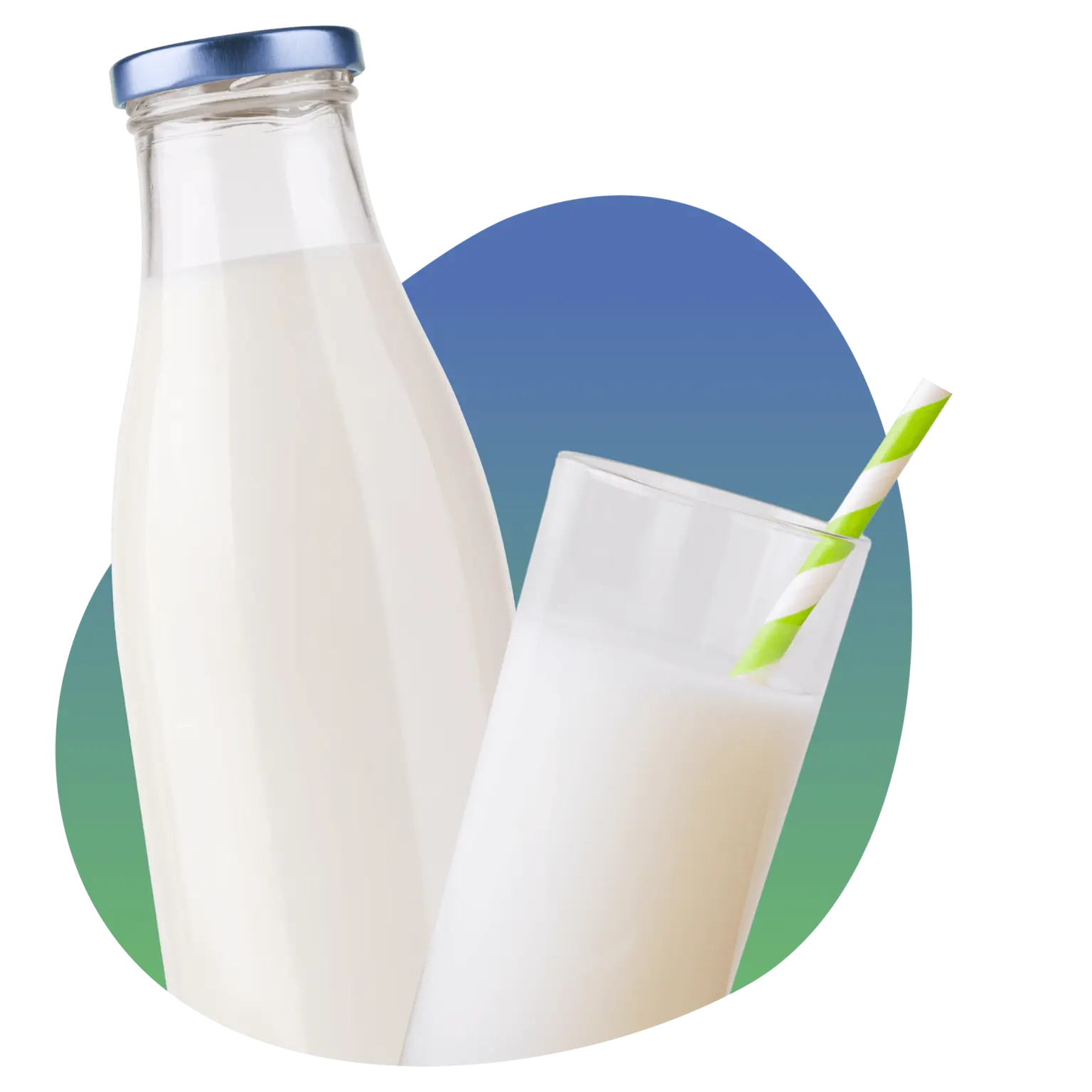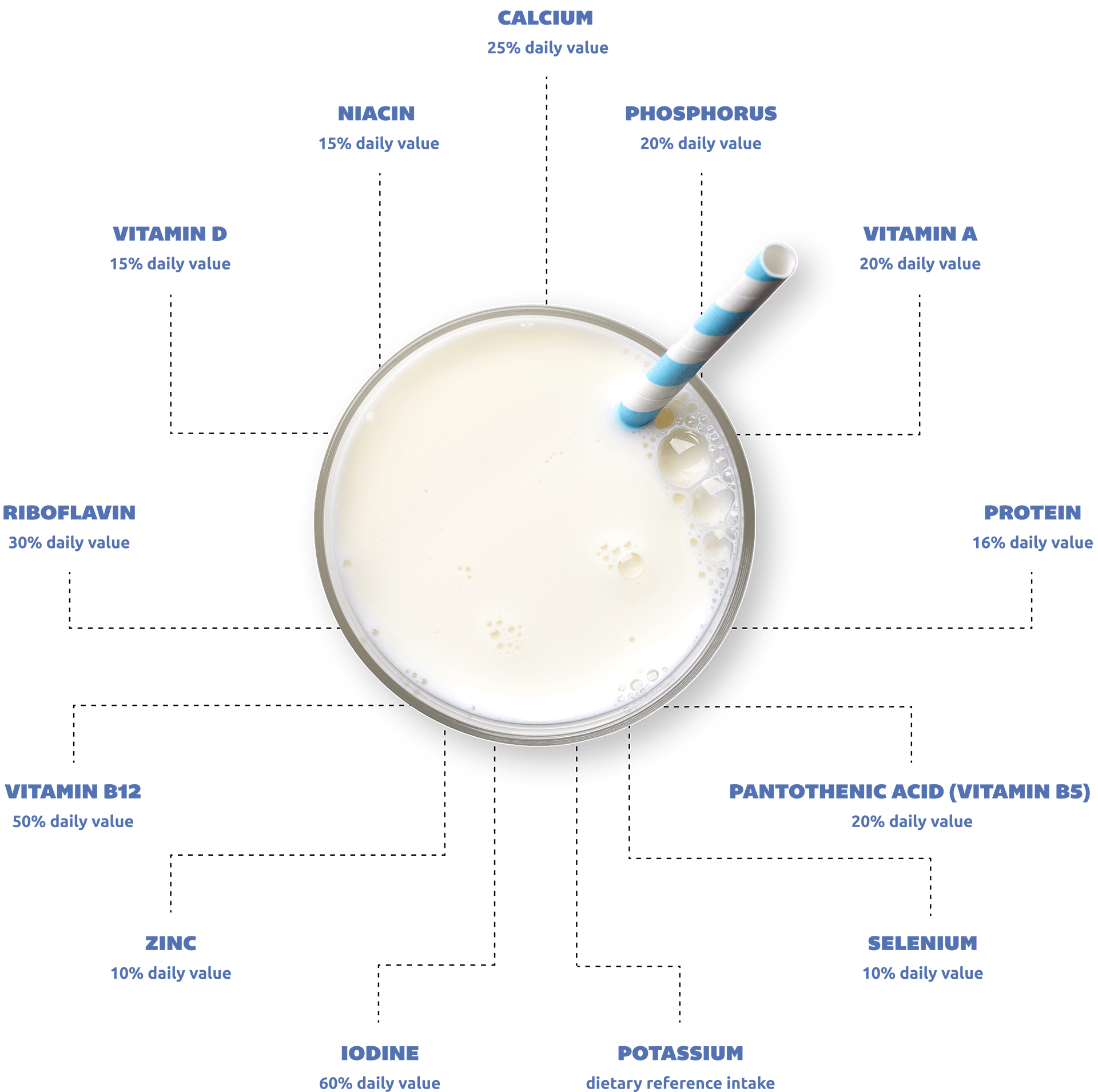All About Milk
A standard eight ounce serving of milk provides 13 essential nutrients, making it one of the most nutrient-dense foods.

The 13 Essential
Nutrients
Each serving of milk provides 10% or more of the recommended daily intake for calcium, Vitamin D (if fortified), protein, pantothenic acid, Vitamin A, Vitamin B12, riboflavin, niacin, phosphorus, selenium, iodine, zinc and potassium.
Milk is well known as an excellent source of calcium. Regardless of its fat content, milk provides eight grams of protein and about 300 milligrams of calcium per serving (eight fluid ounces). A diet that includes three servings of milk (or equivalent dairy foods) each day provides enough calcium and other nutrients that may help reduce the risk of osteoporosis, high blood pressure and colon cancer.
It is difficult to obtain enough calcium without consuming milk (or other dairy foods).
To help meet calcium requirements, the USDA Dietary Guidelines for Americans recommends three (3) cups of low fat or fat free milk and dairy foods daily for those 9 years or older, two and a half (2 1/2) servings for those 4-8 years old and two (2) servings for those 2-3 years old.
One serving of dairy is equal to an eight ounce glass of milk, a six or eight ounce container of yogurt, or one and a half ounces of natural cheese.

VITAMIN D
When fortified, a glass of milk provides about 15% of the daily value for Vitamin D. Vitamin D helps promote the absorption of calcium and enhances bone mineralization. Milk is one of the few dietary sources of this important nutrient.
NIACIN
Niacin is important for the normal function of many enzymes in the body and is involved in the metabolism of sugars and fatty acids. A glass of milk provides 15% of the daily value for niacin.
CALCIUM
An 8-oz serving of milk provides 25% of the daily value of calcium. Calcium helps build and maintain strong bones and teeth. This mineral also plays an important role in nerve function, muscle contraction and blood clotting.
PHOSPHORUS
Phosphorus helps strengthen bones and generates energy in the body’s cells. Milk is an excellent source of phosphorus, providing 20% of the daily value.
VITAMIN A
A glass of milk provides 15% of the daily value of Vitamin A. This nutrient helps maintain normal vision and skin. It also helps regulate cell growth and maintains the integrity of the immune system.
PROTEIN
The protein in milk is high quality, which means it contains all of the essential amino acids in the proportions that the body requires for good health. Protein builds and repairs muscle tissue and serves as a source of energy during high-powered endurance exercise. An 8-oz glass of milk provides about 16% of the daily value for protein.
Pantothenic Acid
(Vitamin B5)
An 8-ounce glass of milk is an excellent source of Pantothenic Acid, also known as Vitamin B5. Pantothenic Acid helps the body to break down carbohydrates and to create energy from them.
SELENIUM
Selenium also helps maintain a healthy immune system, regulate metabolism, and protect healthy cells from damage. One 8 ounce glass of milk provides 10% of the daily value.
POTASSIUM
Potassium helps maintain a healthy blood pressure and supports heart health. This important mineral helps regulate body fluid balance and maintain normal muscle function. One serving of milk provides 10% of the Dietary Reference Intake.
IODINE
An 8-ounce serving of milk is an excellent source of Iodine at 60% of the daily value. Necessary for proper bone and brain development during pregnancy and infancy, Iodine is linked to brain development in childhood.
ZINC
A healthy immune system is important. Zinc helps maintain immune health, support normal growth and development, and healthy skin. One serving of milk provides 10% of the daily value.
VITAMIN B12
Vitamin B12 helps build red blood cells that carry oxygen from the lungs to working muscles. Just one 8-oz glass of milk provides about 50% of the daily value for this vitamin.
RIBOFLAVIN
Milk is an excellent source of riboflavin, providing 24% of the daily value. Riboflavin, also known as Vitamin B2, helps convert food into energy—a process crucial for exercising muscles.
Varieties of Fluid Milk
- Whole Milk
3.25% Fat
Whole milk contains about 150 calories and about 8 grams of fat per serving (8 ounces). Although not required, whole milk may be fortified with Vitamin D at a level of 400 International Units (IU) per quart. If Vitamin D is added, the label must state this fact.
- 2% Reduced-fat Milk
2% Fat
2% reduced-fat milk contains about 120 calories and about 5 grams of fat per serving (8 ounces). Vitamin A is removed with the milk fat. For this reason, Vitamin A must be added to 2% reduced-fat milk so that it contains at least 1,200 IU of Vitamin A per quart although 2,000 IU are typically added based on FDA recommendations. Vitamin D is added to virtually all milk at a level of 400 IU of Vitamin D per quart. The addition of these vitamins must be stated on the label.
- 1% Low Fat Milk
1% fat
1% low fat milk (also called light milk) contains 100 calories and 2.5 grams of fat per serving (8-ounces). Vitamin A is removed with the milk fat. For this reason, Vitamin A must be added to 1% low-fat milk so that it contains at least 1,200 IU of Vitamin A per quart although 2,000 IU are typically added based on FDA recommendations. Vitamin D is added to virtually all milk at a level of 400 IU of Vitamin D per quart. The addition of these vitamins must be stated on the label.
- Fat-free Milk
0% fat
Fat-free milk, also called skim or nonfat milk, contains 80 calories and 0 grams of fat per serving (8 ounces). Vitamin A is removed with the milk fat. For this reason, Vitamin A must be added to fat-free milk so that it contains at least 1,200 IU of Vitamin A per quart although 2,000 IU are typically added based on FDA recommendations. Vitamin D is added to virtually all milk at a level of 400 IU of Vitamin D per quart. The addition of these vitamins must be stated on the label.
- Skim Deluxe Milk
Skim deluxe or skim supreme milk looks like and has the mouthfeel of 2% reduced-fat milk as a result of the addition of a small amount of dietary fiber to the milk. This milk is an option to provide the look and mouthfeel of 2% low fat or whole milk without the extra calories and fat.
- Evaporated Milk
6.5% fat
Evaporated milk is made by removing about 60% of the water from whole milk. The milk is then homogenized, fortified with Vitamin D to a level of 25 IU per 1 ounce, canned and heat sterilized. The addition of Vitamin A is optional. If added, each fluid ounce must contain not less than 125 IU of Vitamin A.
- Evaporated Fat-free Milk
0.5% fat or less
Evaporated fat-free milk is a concentrated, fat-free (skim or nonfat) milk that has been fortified with Vitamins A and D, canned and sterilized.
- Acidophilus/Bifidobacterial Milk
Acidophilus/bifidobacterial milk is a low-fat or nonfat milk to which acidophilus and bifidobacterial cultures have been added. There is some evidence that these cultures have unique health benefits, such as improving lactose digestion, lowering blood pressure and promoting a better balance of bacteria in the gastrointestinal tract.
- Sweetened Condensed Milk
8% fat or less
Sweetened condensed milk is a canned milk concentrate of whole milk to which sugar has been added. The sweetener used (usually sucrose) prevents spoilage. Sweetened condensed fat-free milk contains no more than 0.5% milk fat.
Milk is Local
8 Steps from Farm to Fridge
TOP 5 MILK QUESTIONS ANSWERED
No. In terms of quality, safety and nutrition, there’s no difference between organic and regular milk. The difference is how they are produced on the farm.
No. All milk – both regular and organic – is tested for antibiotics. Even with the best care, animals can become sick or injured. Farmers work with veterinarians to provide medicine to their cows as needed. When this happens, the cow’s milk is withheld from the market and does not enter the food supply. Rigorous testing is done on the farm and at the plant to make sure all milk is free of antibiotics.
No. Milk should be pasteurized; it’s a matter of food safety. Pasteurization is a simple, effective method to kill potentially harmful bacteria without affecting the taste or nutritional value of milk.
No. Hormones are naturally present in many foods of plant and animal origin, including milk. Some farmers choose to supplement their cows with rbST, an FDA-approved synthetic hormone, to help with milk production. Science shows that it is safe for cows and has no effect on humans or the hormone levels in the milk itself.
No. The USDA, EPA and FDA agree that fluid milk from cows fed genetically modified grains like corn and soybeans is not considered genetically modified solely because of the feed. GMO grains are digested by animals in the same ways as non-GMO feed. Nutritionally, the milk is identical.
